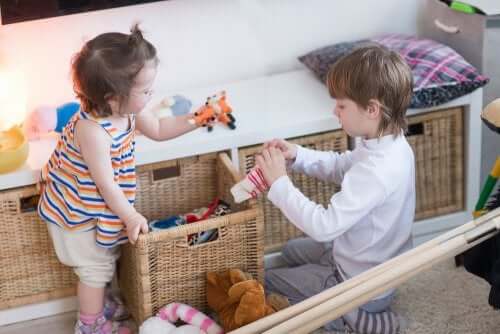Turtle and Dragon Game to Teach Assertiveness

Nowadays, it’s very important to education children about being assertive so they can interact well with others. Little ones have to learn to express their emotions without threats or demands. This turtle and dragon game can be a helpful way for children to learn to be assertive.
Assertive children are able to express their ideas and points of view to others without yelling or using bad manners. They have the ability to value themselves and those around them. Proper development of emotional intelligence during childhood will impact whether or not they’re emotionally and physically strong adults in the future.
Therefore, parents and teachers have to provide children with education based on respect. How can we do that? This turtle and dragon game can help us with that task.
Turtle and dragon game
This game is based on the three ways of expressing ourselves. The dragon represents the aggressive way, the turtle the passive and the person the assertive form.
Ways of communicating
- Dragon: this will be the person who speaks in an aggressive way and who doesn’t listen to anyone else’s feelings or opinions. In addition, they despise the other players. Their tone of voice is loud and sometimes aggressive. Also, they always impose their point of view.

- Turtle: this is totally the opposite of the dragon. They don’t express their feelings or defend their opinions. The turtle hides inside their shell and always accepts everyone else’s opinions. They never take their own opinion into account.
- Person: this is the figure that carries out the assertive communication. They’re the person who expresses their emotions, ideas or thoughts in an appropriate way. In addition, they always respect and listen to others’ ideas.
Objectives of the turtle and dragon game
- Develop the ability to express yourself in an appropriate way without being afraid. Learn not to be too aggressive or too passive.
- Teach the little ones that they have to defend themselves and express themselves without hurting others.
- Encourage positive communication.
Materials
- 3 pieces or figures to represent the dragon, turtle and person.
You can make the 3 cards with your children. You can make the drawings yourselves or get them already drawn and have the children paint them.
Number of players
If you do it at home, the whole family can play (dad, mom, little siblings, etc.). Or, if you’re playing at school, you’ll want at least 6 children.
Ages
Children around the age of 6 can play this game. Additionally, if a younger child has strong reasoning skills, they could play as well.
How to play
- If you’re at home, distribute the cards with the three figures between mom, dad and the kids. But don’t say which card you have.
- If you’re at school, form groups of three and distribute the cards. Again, don’t let the other teams know which card you have.
Think of a situation or problem
For example:
You’re at home playing with the toys in your room, you finish and leave it a total mess with your toys everywhere. Mom is upset that you didn’t clean your room, like she always tells you to do.

Choose your reaction depending on your card
- You tell your mom there’s a lot of toys on the ground and you’ve been overwhelmed. However, you’re going to pick everything up and, if you need help, you’ll ask her.
- You look at her without saying anything and you don’t respond. Instead, you just hang your head and get sad.
- You answer that you don’t want to pick up your toys because you’re really tired. Also, you say it seems unfair that you have to pick your toys up all by yourself. You always get mad when you have to pick your toys up.
Of course, this is just an example. You can come up with other situations, whether you’re doing it at school or at home. You just have to adapt the situation to the place where you’re playing the game.
It’s important that each player plays the round as their character, then everyone switches cards. This will help the child associate each figure with their actions. Then, they can see what it’s like to be assertive, or to lack assertiveness.
As you can see, the turtle and dragon game is a very fun way for children to learn communication styles. We can play at home, and your child can learn and have fun with the whole family. Or, they can play at school with their teacher.
Remember that play is a very effective way for children to learn new things in a fun way. So, have fun learning!
Nowadays, it’s very important to education children about being assertive so they can interact well with others. Little ones have to learn to express their emotions without threats or demands. This turtle and dragon game can be a helpful way for children to learn to be assertive.
Assertive children are able to express their ideas and points of view to others without yelling or using bad manners. They have the ability to value themselves and those around them. Proper development of emotional intelligence during childhood will impact whether or not they’re emotionally and physically strong adults in the future.
Therefore, parents and teachers have to provide children with education based on respect. How can we do that? This turtle and dragon game can help us with that task.
Turtle and dragon game
This game is based on the three ways of expressing ourselves. The dragon represents the aggressive way, the turtle the passive and the person the assertive form.
Ways of communicating
- Dragon: this will be the person who speaks in an aggressive way and who doesn’t listen to anyone else’s feelings or opinions. In addition, they despise the other players. Their tone of voice is loud and sometimes aggressive. Also, they always impose their point of view.

- Turtle: this is totally the opposite of the dragon. They don’t express their feelings or defend their opinions. The turtle hides inside their shell and always accepts everyone else’s opinions. They never take their own opinion into account.
- Person: this is the figure that carries out the assertive communication. They’re the person who expresses their emotions, ideas or thoughts in an appropriate way. In addition, they always respect and listen to others’ ideas.
Objectives of the turtle and dragon game
- Develop the ability to express yourself in an appropriate way without being afraid. Learn not to be too aggressive or too passive.
- Teach the little ones that they have to defend themselves and express themselves without hurting others.
- Encourage positive communication.
Materials
- 3 pieces or figures to represent the dragon, turtle and person.
You can make the 3 cards with your children. You can make the drawings yourselves or get them already drawn and have the children paint them.
Number of players
If you do it at home, the whole family can play (dad, mom, little siblings, etc.). Or, if you’re playing at school, you’ll want at least 6 children.
Ages
Children around the age of 6 can play this game. Additionally, if a younger child has strong reasoning skills, they could play as well.
How to play
- If you’re at home, distribute the cards with the three figures between mom, dad and the kids. But don’t say which card you have.
- If you’re at school, form groups of three and distribute the cards. Again, don’t let the other teams know which card you have.
Think of a situation or problem
For example:
You’re at home playing with the toys in your room, you finish and leave it a total mess with your toys everywhere. Mom is upset that you didn’t clean your room, like she always tells you to do.

Choose your reaction depending on your card
- You tell your mom there’s a lot of toys on the ground and you’ve been overwhelmed. However, you’re going to pick everything up and, if you need help, you’ll ask her.
- You look at her without saying anything and you don’t respond. Instead, you just hang your head and get sad.
- You answer that you don’t want to pick up your toys because you’re really tired. Also, you say it seems unfair that you have to pick your toys up all by yourself. You always get mad when you have to pick your toys up.
Of course, this is just an example. You can come up with other situations, whether you’re doing it at school or at home. You just have to adapt the situation to the place where you’re playing the game.
It’s important that each player plays the round as their character, then everyone switches cards. This will help the child associate each figure with their actions. Then, they can see what it’s like to be assertive, or to lack assertiveness.
As you can see, the turtle and dragon game is a very fun way for children to learn communication styles. We can play at home, and your child can learn and have fun with the whole family. Or, they can play at school with their teacher.
Remember that play is a very effective way for children to learn new things in a fun way. So, have fun learning!
This text is provided for informational purposes only and does not replace consultation with a professional. If in doubt, consult your specialist.








